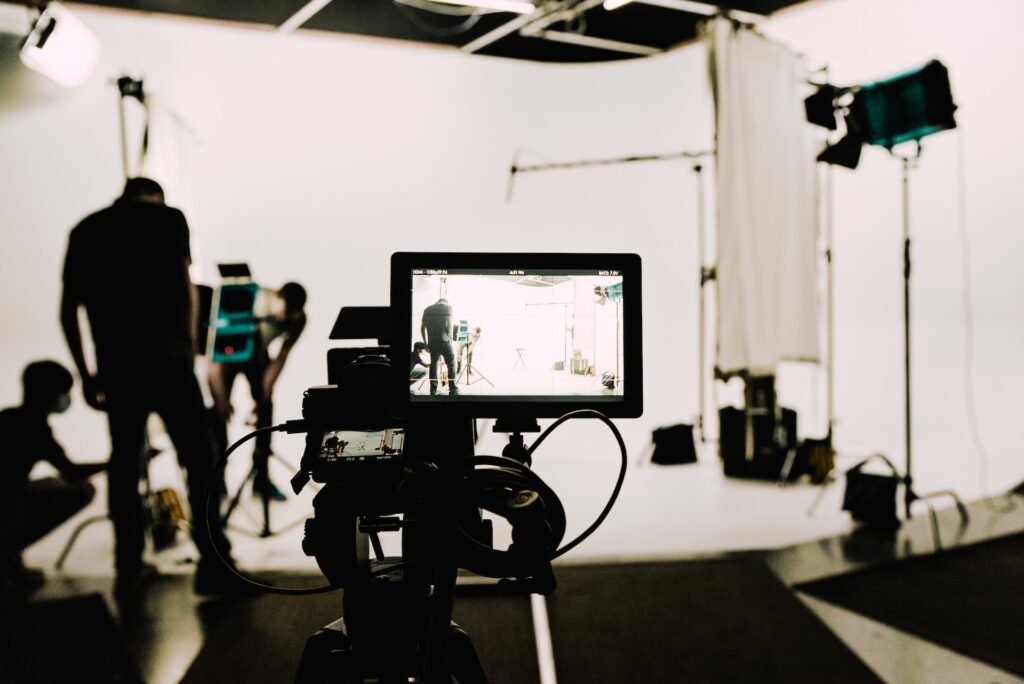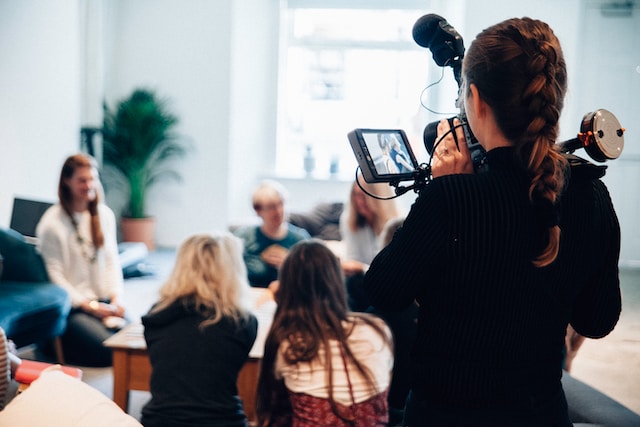Home » My Blog
Category Archives: My Blog
5 Ways to Improve Your Video’s Sound Quality

Video content has become a dominant force in modern communication. Whether you’re a vlogger, a content creator, or a business looking to engage your audience, the quality of your video’s sound can make or break its effectiveness. Here are five actionable tips to ensure your audio enhances rather than detracts from your visual content.
1. Invest in Quality Microphones
The type and quality of the microphone you use plays a crucial role in capturing clear and crisp audio. While built-in microphones on cameras or smartphones can suffice for casual recordings, investing in dedicated microphones significantly improves sound quality. Consider options like shotgun microphones for directional audio or lapel microphones for interviews and presentations. Quality microphones can minimize background noise and capture the intended audio accurately, especially if the video is heavy with dialogue.
2. Control Your Recording Environment
The environment in which you record greatly influences the quality of your audio. Choosing quiet locations with minimal background noise is best to prevent distractions in your recordings. If recording indoors, you can utilize acoustic treatment such as sound-absorbing panels to minimize echo and reverberation. For outdoor shoots, consider wind protection accessories to mitigate wind noise. Controlling your recording environment ensures clearer audio capture from the outset.
3. Master Audio Levels and Dynamics
Balancing audio levels and dynamics is essential for a polished final product. Utilize audio meters to monitor volume levels and prevent clipping or distortion. In post-production, use audio editing software to adjust levels, equalize frequencies, and apply dynamic range compression. Properly mastering your audio ensures consistent volume levels and clarity throughout your video, further enhancing the viewer’s listening experience.
4. Sync Audio and Video Seamlessly
Mismatched audio and video can be a jarring experience for viewers. When using external microphones, ensure proper synchronization with your video footage during editing. Utilize clapboards or synchronization markers during recording to simplify the syncing process. Additionally, consider recording audio separately and syncing it with your video in post-production to have better control and flexibility. Seamless audio-video synchronization maintains immersion and professionalism in your content.
5. Regularly Monitor and Test Your Setup
Consistently monitoring and testing your audio setup is key to maintaining optimal sound quality. Before each recording session, conduct a sound check to identify and address any potential issues. Test different microphone placements, adjust audio settings, and listen for unwanted noise or distortion. Regular maintenance, including cleaning and replacing worn components, ensures reliable performance and high-quality audio output.
Elevate Your Audio, Elevate Your Content
The sound quality of your video plays a key role in its overall impact. Consider investing in quality equipment and controlling your recording environment to improve this. Make sure to master your audio levels and synchronize audio with video seamlessly. Regular testing of your setup is also essential. By doing so, you’ll elevate the audio experience for your audience. This will make your content more captivating and engaging than ever before.
Take your video content to the next level with these tips on sound quality. Implement them in your next recording session and notice the difference firsthand!
7 Common Issues Faced by Beginners in Video Production

Embarking on the exciting journey of video production can be both thrilling and challenging for beginners. The world of filmmaking is dynamic and multifaceted, but often, newcomers find themselves grappling with common issues that can impede their progress. Here are seven of the most prevalent challenges faced by beginners in video production and offer insights on how to overcome them.
1. Equipment Overwhelm
Newcomers are often confronted with a plethora of video production equipment, ranging from cameras and microphones to lighting setups. The sheer variety can be overwhelming. To address this, it’s crucial to start with the basics. Invest time in understanding the functions of your equipment, gradually incorporating more advanced tools as your skills evolve. Begin with a good quality camera, reliable audio equipment, and basic lighting to build a strong foundation.
2. Poor Scripting and Planning
Video production is not just about capturing stunning visuals; it’s also about storytelling. Many beginners fall into the trap of neglecting proper scripting and planning, leading to a lack of direction in their projects. Take the time to develop a solid script, storyboard, and shot list before diving into filming. This will not only enhance the overall quality of your video but also streamline the production process.
3. Inadequate Lighting
Lighting plays a pivotal role in video production, yet it’s a commonly overlooked aspect by beginners. Poor lighting can result in grainy footage and distract from the content. To overcome this issue, familiarize yourself with basic lighting techniques. Experiment with natural light and affordable artificial lighting sources to enhance the visual appeal of your videos.
4. Audio Challenges
Clear and crisp audio is just as important as high-quality visuals. Beginners often struggle with capturing good sound, leading to videos with distracting background noise or muffled dialogue. Invest in a decent external microphone, pay attention to the acoustics of your shooting location, and consider using post-production tools to enhance audio quality.
5. Overlooking Editing Techniques
Video editing is a skill that takes time to master, and many beginners make the mistake of neglecting its importance. Learning the basics of video editing software is essential for creating a polished final product. There are numerous online tutorials and courses available to help you grasp the fundamentals of editing, from cutting and trimming to adding effects and transitions.
6. Lack of Patience and Persistence
The learning curve in video production can be steep, leading some beginners to become discouraged or impatient. Understand that improvement takes time and persistence. Celebrate small victories, learn from mistakes, and keep honing your skills. Joining online communities or local groups of fellow videographers can provide valuable support and encouragement.
7. Ignoring Feedback
Constructive criticism is a powerful tool for growth, yet many beginners shy away from seeking or accepting feedback. Embrace criticism from peers or mentors to identify areas for improvement. Constructive feedback can offer fresh perspectives, helping you refine your techniques and enhance the overall quality of your videos.
Conclusion
Embarking on a journey in video production is an exciting endeavor, but it comes with its fair share of challenges. By addressing these common issues head-on, beginners can navigate the complexities of filmmaking more effectively. Remember, each hurdle is an opportunity to learn and grow, bringing you one step closer to mastering the art of video production. So, equip yourself with knowledge, practice consistently, and enjoy the rewarding process of creating captivating visual stories.
6 Mobile Video Production Tips for Small Businesses

Visual content reigns supreme in today’s digital age. Small businesses are seeking innovative ways to connect with their audience. Mobile video production has emerged as a cost-effective and powerful tool for businesses looking to make a lasting impression. If you’re considering enhancing your brand through compelling videos, read on for six mobile video production tips that will transform your content and set you apart from the competition.
1. Choose the Right Equipment
Your smartphone is more than just a communication device; it’s a powerful tool for video production. When searching for video production near me in Brookfield, CT, consider the importance of a good smartphone camera. Explore popular smartphone cameras and learn how to maximize their capabilities for stunning visuals. Additionally, invest in external microphones and stabilizers for improved audio quality and steady shots, ensuring your videos are polished and professional.
2. Optimize Lighting for Professional Results
Whether you’re showcasing your products or conveying your brand’s story, lighting plays a crucial role in mobile video production. Take advantage of natural light for a softer look and master the use of artificial lighting to enhance details. As businesses strive for professional-looking videos, understanding and implementing proper lighting techniques will set your content apart.
3. Learn the Art of Framing and Composition
As you search for video production near me in Brookfield, CT, understand the significance of framing and composition. Utilize the rule of thirds, leverage the grid feature on your smartphone, and incorporate varied shots for storytelling. From close-ups for emotional impact to wide shots for context, mastering the art of framing and composition ensures your videos are visually compelling.
4. Master Basic Editing Techniques
Editing is the secret sauce that transforms raw footage into a polished masterpiece. Explore mobile video editing apps available near you in Brookfield, CT, and understand their features and functionality. Trim unnecessary footage, add seamless transitions, and incorporate music to enhance the overall viewer experience. These basic editing tips will elevate the quality of your videos and captivate your audience.
5. Optimize Videos for Social Media Platforms
To maximize the reach of your videos, understand the requirements of different social media platforms. Whether it’s Facebook, Instagram, or TikTok, tailor your videos to meet specific aspect ratios and maximum video lengths. For businesses in Brookfield, CT, looking to enhance accessibility, consider adding captions and subtitles to your videos, making them more inclusive and engaging.
6. Promote Videos for Maximum Reach
Once your videos are crafted to perfection, it’s time to promote them strategically. Small businesses in Brookfield, CT, can leverage social media algorithms by maintaining a consistent posting schedule and encouraging audience engagement through comments and shares. Consider collaborations with influencers and other local businesses for cross-promotion, maximizing exposure, and establishing your brand’s presence.
As you explore video production near me in Brookfield, CT, these six mobile video production tips serve as a roadmap to elevate your brand’s visual storytelling. By implementing these strategies, you’ll not only create compelling content but also position your business for success in the competitive digital landscape. Embrace the power of mobile video production and watch your brand thrive.
Transform Your Brand and Explore Expert Video Production!
Elevate your brand with captivating videos by partnering with Video Production CT. The dedicated team understands the unique needs of small businesses and specializes in implementing cutting-edge tips. From choosing the right equipment to optimizing lighting, framing, and editing, businesses can now benefit from professional videos that engage their audience and set them apart from the competition. Interested parties are encouraged to contact Video Production CT today and embark on a journey to transform their brand visually with top-tier video production!
Video Production CT
604 Federal Rd Room 1, Brookfield, CT 06804, United States
Phone Number: +12034086700
Top Cinematography Techniques for Cinematic Video Production
Cinematography is the art and science of capturing images in motion, and it plays a pivotal role in shaping the visual storytelling of cinematic video production. Whether you’re a budding filmmaker or an experienced videographer, understanding and applying cinematography techniques can elevate the quality of your work to new heights.
Lighting Techniques
Lighting is the backbone of cinematography. It sets the mood, directs the viewer’s attention, and enhances the overall visual appeal of your video production. The three-point lighting technique, comprising the key light, fill light, and backlight, is a cornerstone of cinematic lighting. Mastering this technique is essential for achieving balanced and dramatic lighting in your videos. Additionally, harnessing the power of natural light and understanding color temperature are key components of proficient cinematography.
Composition and Framing
The way you frame and compose your shots has a profound impact on the storytelling aspect of your video production. Employing the rule of thirds, using leading lines, and framing your subjects creatively can significantly enhance the visual narrative. Moreover, being aware of aspect ratios ensures that your videos are formatted correctly for different platforms and screens.
Camera Movement
Dynamic camera movement can add depth and excitement to your cinematic video production. Whether it’s the smooth elegance of dolly shots, the sweeping perspectives of crane shots, the versatility of Steadicam shots, or the raw energy of handheld shots, understanding when and how to use each technique is crucial. Additionally, having access to reliable camera stabilization equipment is essential for achieving professional-looking footage.
Depth of Field
Depth of field (DOF) is a powerful tool that can influence the focus and visual hierarchy in your video production. By manipulating DOF, you can draw attention to specific elements in the frame and create a sense of depth. Whether you opt for a shallow DOF to isolate your subject or a deep DOF to capture expansive landscapes, understanding and controlling DOF is a fundamental skill.
Color Grading
In cinematic video production, color grading is the final touch that can transform your footage into a work of art. It involves color correction, enhancing or altering color tones, and establishing a consistent visual style. The right color grading can evoke emotions, set the tone, and create a cohesive look for your video.
Lens Selection
The choice of lenses can dramatically impact the aesthetics and storytelling of your cinematic video production. Wide-angle lenses can capture sweeping vistas, standard lenses provide a natural perspective, and telephoto lenses bring distant subjects closer. Knowing when to use each type of lens is crucial for achieving your desired visual outcome.
Previsualization and Storyboarding
Previsualization is the process of planning your shots and visualizing the entire video production before you even pick up a camera. Storyboarding, in particular, is an invaluable tool for mapping out your scenes, angles, and compositions. Effective pre-planning ensures that you capture the shots needed to tell your story seamlessly.
Conclusion
Mastering cinematography techniques is essential for anyone serious about cinematic video production. From lighting and composition to camera movement and sound design, each element plays a vital role in crafting visually compelling narratives. By incorporating these techniques into your work, you can elevate the quality of your video production and create content that captivates and resonates with your audience.
Factors to Consider When Choosing the Right Business Tax Accountant

When it comes to finance and taxation, having a reliable business tax account in New York City is essential for any successful enterprise. It’s crucial to understand the critical factors to consider when selecting the right professional to manage your business’s tax obligations.
Qualifications and Experience
The qualifications and experience of your tax accountant are paramount. Look for professionals with the necessary certifications, such as Certified Public Accountants (CPAs) or Enrolled Agents (EAs). Their experience in your industry or with businesses of similar size is equally important. Ensure they have a thorough understanding of the latest tax laws and regulations, as this knowledge is critical in managing your business tax effectively.
Reputation and References
A reliable way to gauge the quality of a business tax account in New York City is through their reputation. Online reviews, ratings, and recommendations from fellow business owners can provide valuable insights. Don’t hesitate to ask for case studies or testimonials from previous clients, as these can highlight the accountant’s expertise and success in handling complex tax issues.
Service Scope and Specialization
The range of services offered by a tax accountant can vary significantly. Some may specialize in tax planning, compliance, auditing, or a specific tax area like sales tax or international tax. Ensure that the accountant you choose can offer tailored solutions to meet the unique challenges your business may face.
Communication and Availability
Effective communication is key in any professional relationship, especially when it involves your business’s finances. Evaluate the accountant’s responsiveness, their ability to explain complex tax concepts clearly, and their availability for meetings and urgent queries. This ensures a smooth and transparent working relationship.
Fee Structure and Transparency
Understanding the fee structure of your business tax accountant is crucial. Compare different pricing models — hourly rates, fixed fees, or retainers — and assess which is most cost-effective for your business. Transparency in billing and fees is non-negotiable to avoid unexpected costs.
Technology and Tools
The use of modern accounting software and tools is a must for all business accounts. Check if the accountant’s tools are compatible with your business’s financial systems. Emphasize the importance of data security and confidentiality in your discussions.
Long-term Relationship Potential
Choosing a business tax account in New York City is not just a short-term decision. Consider the potential for a long-term partnership. The right accountant should be able to adapt to your evolving business needs and play a significant role in strategic planning and financial decision-making.
Legal and Ethical Considerations
Ensure that your chosen accountant adheres to all legal and ethical standards in the industry. Steer clear of professionals with a history of malpractice or ethical issues. The confidentiality and trust inherent in your relationship with your business tax accountant are of utmost importance.
Connect With Tax Accountant – Fincadia | Your Business Tax Solution in NYC
Whether you’re a small startup or a large corporation, Tax Accountant – Fincadia is equipped to handle your tax concerns with the utmost professionalism and care. Their team of dedicated professionals is equipped to handle all your tax needs, ensuring compliance and optimizing your financial performance. Visit their website to learn more about their offerings.
Tax Accountant – Fincadia
5 Hanover Square 12th Floor, New York, NY 10004, United States
Phone Number: +19179249934
How to Choose the Perfect Music and Soundtrack for Your Videos

Music is a powerful tool in video production, capable of setting the mood, enhancing emotions, and creating a memorable viewing experience. Whether you’re making a short film, a marketing video, or a vlog, selecting the right music and soundtrack is essential. In this article, we’ll explore how to choose the perfect music and soundtrack for your videos to make them more engaging and impactful.
1. Understand Your Video’s Purpose
Before selecting music, clarify the purpose and message of your video. Is it an upbeat promotional video, a heartfelt family vlog, or a dramatic short film? Understanding the video’s purpose will guide your music choices.
2. Consider the Audience
Think about your target audience. What kind of music will resonate with them? Consider their age, preferences, and cultural background when selecting the soundtrack.
3. Match the Mood
Music plays a significant role in setting the mood of your video. Choose music that aligns with the emotional tone you want to convey. Common moods include:
- Upbeat and Energetic: Ideal for promotional videos, product showcases, and vlogs that aim to inspire enthusiasm.
- Melancholic and Reflective: Suitable for emotional storytelling, documentaries, and videos that explore deeper themes.
- Suspenseful and Dramatic: Enhances tension and anticipation in action sequences, thrillers, or suspenseful content.
4. Use Royalty-Free Music
To avoid copyright issues, use royalty-free music or licensed tracks for your videos. Numerous online platforms offer a wide selection of music that you can use legally and without worrying about copyright infringement.
5. Align with Branding
If you’re creating videos for a brand or business, select music that aligns with the brand’s identity and values. Consistency in music choices can reinforce brand recognition.
6. Pay Attention to Timing
Consider the tempo and rhythm of the music in relation to the pacing of your video. Fast-paced music can add excitement, while slower rhythms can create a more relaxed atmosphere.
7. Use Music to Enhance Storytelling
Music can help tell your video’s story. Use it to underscore key moments, transitions, or emotional peaks in the narrative. The music should complement the visuals and dialogue.
8. Experiment with Instrumentation
Different instruments can evoke different emotions. Experiment with instrumental choices to find the right sound for your video. For example, strings can add elegance, while electronic beats can create energy.
9. Consider Licensing and Permissions
If you’re using popular or well-known music tracks, ensure you have the necessary licensing or permissions to use them in your videos. Licensing fees may apply for commercial use.
10. Test with Your Audience
If possible, test your video with a small audience or focus group to gather feedback on the music’s effectiveness. Their insights can help you refine your soundtrack choices.
11. Edit Music to Fit
Adjust the length and timing of the music to match the video’s duration and pacing. Use editing software to fade in and out, loop sections, or synchronize music with specific scenes.
12. Balance Music and Audio
Ensure the music doesn’t overpower the video’s audio, such as dialogue or narration. Balance the volume levels to maintain clarity.
13. Original Music Compositions
Consider commissioning or creating original music compositions for your videos. Custom music can provide a unique and memorable soundtrack tailored to your project.
Elevate Your Video with the Right Soundtrack
Choosing the perfect music and soundtrack for your videos is a creative process that can significantly impact your audience’s experience. By understanding your video’s purpose, considering the audience, and aligning the music with the mood and story, you can create videos that are engaging, memorable, and emotionally resonant.
How to Create Visual Storytelling That Captivates Audiences

Video has become one of the most powerful tools for communication and storytelling. Whether for marketing purposes, entertainment, education, or documentation, video production plays a crucial role in effectively conveying messages and emotions. Let’s explore how to create captivating visual stories that leave a lasting impact on your audience.
1. Pre-production: The Foundation of a Successful Video
Before hitting the record button, meticulous planning and preparation are essential. The pre-production phase sets the stage for a successful video production journey. Here’s what you need to consider:
- Scripting: Start with a well-crafted script. It’s the backbone of your video, guiding the narrative and ensuring your message is clear and concise.
- Storyboarding: Visualize your ideas by creating a storyboard. This will help you plan your shots, transitions, and overall visual style.
- Location Scouting: The right location can make or break your video. Scout for locations that fit your story and ensure they are accessible and safe.
- Casting: If your video involves actors, casting is crucial. Choose performers who can convey the emotions and messages you want to communicate.
2. Cinematography: The Art of Visual Storytelling
Cinematography is the heart of video production. It’s about capturing the right shots, framing, and camera movements to evoke emotions and engage your audience. Here are some key aspects of cinematography:
- Camera Selection: Choose the right camera for your project. Different cameras offer various features and capabilities, so select one that suits your needs and budget.
- Lighting: Proper lighting is essential for creating a mood and highlighting key elements. Experiment with natural, artificial, and shadows to achieve the desired effect.
- Composition: Pay attention to framing, rule of thirds, and leading lines. These techniques can enhance the visual appeal of your video.
- Camera Movement: Employ techniques like pans, tilts, and dollies to add dynamic elements to your shots. Steady camera work is crucial for a professional look.
3. Post-production: Polishing Your Masterpiece
After capturing your footage, it’s time to bring it to life through post-production. This phase involves editing, sound design, and visual effects:
- Editing: Cut together your footage, add transitions, and trim unnecessary content. Editing is where the story truly comes together.
- Sound Design: Sound is half of the video experience. Use music, dialogue, and sound effects to enhance the emotional impact of your video.
- Color Correction: Adjust the colors and tones of your footage to create a consistent and visually appealing look.
- Visual Effects: If your project requires special effects or animations, incorporate them seamlessly into your video.
4. Distribution and Promotion
Once your video is complete, it’s time to share it with the world. Here are some tips for effective distribution and promotion:
- Choose the Right Platforms: Select platforms that align with your target audience. YouTube, Vimeo, and social media are popular choices.
- Optimize for SEO: Use relevant keywords and descriptions to improve the discoverability of your video on search engines and social media.
- Engage with Your Audience: Respond to comments and engage with your viewers. Building a community around your content can lead to a loyal following.
- Share on Multiple Channels: Don’t limit yourself to just one platform. Share your video across multiple channels to reach a broader audience.
Video production is an intricate art form that combines creativity, technical expertise, and storytelling. You can create videos that captivate and resonate with your audience by mastering the pre-production, cinematography, and post-production phases and effectively distributing your content. So, go ahead and embark on your video production journey, and let your visual stories leave a lasting impact on the world.
The Dos and Don’ts of Video Production for Corporate Videos

Corporate videos have become essential tools for businesses aiming to engage, inform, and captivate their target audience. A well-executed corporate video can leave a lasting impression, boost brand recognition, and drive conversions. However, achieving these goals requires a strategic approach to video production. This comprehensive guide will explore the dos and don’ts of video production for corporate videos to help your business create compelling and effective visual content.
Do’s
Pre-Production
Define Clear Objectives
At the heart of every successful corporate video lies a clear objective. Before you even pick up a camera, defining what you want to achieve with your video is crucial. Are you aiming to introduce a new product, share your company’s story, or educate your audience about your industry? These objectives will shape the entire production process, ensuring that your video’s elements align with your goals.
Script and Storyboarding
Crafting a captivating narrative is essential for holding your audience’s attention. Start by creating a well-structured script that conveys your message concisely and effectively. Visualizing your video’s flow through storyboards helps ensure your narrative remains engaging and on point.
Select the Right Team
Building a team of skilled professionals is fundamental to the success of your video production. From experienced directors and cinematographers to talented actors and crew members, assembling the right team ensures that every aspect of your video is executed flawlessly. Collaboration is key, so foster an environment where creativity can thrive.
Production
Invest in High-Quality Equipment
Quality matters. Invest in the best cameras, lighting, and audio equipment your budget allows. The difference between amateur and professional-looking videos often boils down to the tools used in production. High-quality equipment ensures crisp visuals and clear audio, making your video stand out.
Proper Lighting and Set Design
Creating a visually appealing setting can elevate your corporate video from mundane to exceptional. Mastering lighting and set design techniques is essential for achieving the desired mood and atmosphere. Consider the visual elements that will support your narrative and brand image.
Capture Clear Audio
Remember to underestimate the power of clear and crisp audio. Poor audio quality can detract from even the most stunning visuals. Invest in high-quality microphones and record in controlled environments to ensure your message is clear and heard.
Post-Production
Professional Editing
Editing is where the magic happens. A skilled editor can transform raw footage into a polished masterpiece. Ensure your editor is well-versed in storytelling techniques, pacing, transitions, and effects to enhance the viewer’s experience.
Graphics and Animation
Graphics and animations can be powerful tools to reinforce your message and brand identity. When used judiciously, they can add depth and engagement to your video. However, remember that less is often more in this regard. Overloading your video with graphics can be distracting.
Don’ts
Pre-Production
Neglecting Research
Failing to understand your target audience and competition can lead to misguided content. Thorough research forms the foundation of your video, enabling you to tailor your message effectively.
Ignoring Legal and Compliance Issues
Using copyrighted materials without permission can result in legal consequences. Ensure you have the proper rights and permissions for any content you include in your video.
Production
Rushing the Process
Rushing through the shoot can compromise the quality of your video. Allocate sufficient time for each production stage to ensure everything is noticed.
Lack of Proper Direction
A lack of clear direction on set can lead to confusion and inefficiency. A director’s role is crucial in guiding the team to execute the vision effectively.
Post-Production
Over-Editing
While post-production allows for creative enhancements, overdoing it with special effects and editing can overshadow your message. Keep it balanced and focused on your objectives.
Neglecting Distribution Strategy
Your video is complete with a solid distribution plan. Refrain from assuming that a great video will automatically reach your audience. Develop a strategy for promoting and sharing your corporate video effectively.
Afterthoughts
Mastering corporate video production requires a strategic approach, attention to detail, and a commitment to excellence. By following the dos and don’ts outlined in this guide, your business can create engaging and effective corporate videos that impact your audience, enhance your brand image, and drive meaningful results. Elevate your video production game and watch your business soar.
How to Transform Your Smartphone into a Video Production Tool
In today’s digital age, the smartphone has become an indispensable tool, empowering us to capture life’s moments with just a tap. However, its potential goes beyond casual snapshots; it can be a dynamic video production powerhouse in your pocket. With advancements in smartphone camera technology, various accessories, and an array of apps, you can now create professional-quality videos that captivate audiences. In this guide, we will unveil the secrets to harnessing your smartphone’s potential and transforming it into a remarkable video production tool.

Choosing the Right Smartphone
Not all smartphones are created equal when it comes to video production. Understanding key camera specifications such as megapixels, aperture, and sensor size. Look for a device with high-quality video recording capabilities, allowing you to shoot in 4K or even higher resolutions. Moreover, opt for a smartphone that supports third-party apps and accessories, giving you more creative control.
Essential Accessories for Video Production
You’ll need a few accessories to create videos that rival Hollywood productions. A sturdy tripod or stabilizer ensures steady shots, providing a professional touch to your content. External microphones are essential for clear audio capture, especially in noisy environments. Lens attachments allow you to experiment with different visual effects, while portable lighting solutions ensure your scenes are well-illuminated, even in challenging conditions.
Mastering the Art of Composition
Composition is the heart of visual storytelling. The rule of thirds guides you in placing key elements off-center, creating balanced and visually pleasing shots. Framing and perspective add depth to your videos while leading lines and symmetry draw viewers’ eyes to focal points. These techniques transform mundane scenes into captivating narratives.
Lighting Techniques for Outstanding Videos
Lighting sets the mood for your videos. Natural light is versatile, lending itself to different emotional tones. The three-point lighting technique offers professional illumination for indoor shoots, highlighting subjects while maintaining a pleasing balance. Shadows and highlights create drama, evoking powerful emotions that resonate with your audience.
Capturing High-Quality Audio
Crystal-clear audio is often underestimated but holds immense importance in video production. Invest in an external microphone that suits your needs, whether a Lavalier mic for interviews or a shotgun mic for capturing ambient sounds. Minimize background noise to ensure your message is heard loud and clear.
Exploring Advanced Camera Settings
Mastering your smartphone’s manual settings opens a realm of creative possibilities. Adjust focus, exposure, and white balance to control the look and feel of your videos. Tailor frame rates and resolutions for different scenarios, whether silky-smooth slow-motion shots or vibrant time-lapses.
Essential Apps for Video Production
A plethora of apps awaits to enhance your video production process. Video recording apps with manual controls let you fine-tune settings for optimal results. Video editing apps, from basic to advanced, enable seamless content creation. Elevate your videos with color correction and grading apps, lending a cinematic touch to your creations.
Pre-production Planning and Storyboarding
Every masterpiece begins with a plan. Define your video’s purpose and target audience. Scriptwriting and shot lists streamline your production process. Storyboarding helps you visualize the flow of your video, ensuring a coherent and engaging narrative.
Filming Techniques and Tips
Implement smooth camera movements such as panning, tilting, and tracking shots for cinematic flair. Experiment with dynamic angles like low shots for grandiosity and high shots for vulnerability. Add depth to your videos by incorporating foreground and background elements.
Editing and Post-Production Process
Bring your footage to life through the editing process. Organize your clips, trim segments, and use transitions for seamless flow. Advanced editing includes music integration, effects, and color grading, culminating in a polished masterpiece.
Your Smartphone, Your Creative Hub
In a world where innovation knows no bounds, your smartphone emerges as a tool of boundless creativity. You can transform your smartphone into a video production powerhouse by embracing its potential, learning the ropes, and practicing diligently. Unleash your imagination, tell compelling stories, and watch as your videos captivate the world. The journey from smartphone user to video production virtuoso begins now.
5 Tips for Tapping Into the International Market With Video Production
In today’s interconnected world, businesses have the opportunity to expand their reach and attract customers from all corners of the globe. With the power of creative video marketing, you can effectively target an international audience and capture their attention. Here are five tips to help you attract foreign customers through creative video marketing.

1. Understand Cultural Differences
When targeting an international audience, it’s essential to be aware of cultural differences and tailor your video content accordingly. Different cultures have distinct values, traditions, and communication styles, so it’s crucial to do your research and understand the cultural nuances of your target markets. Incorporate elements that resonate with the specific culture, such as language, symbols, and references, to create a connection with your foreign audience. By demonstrating cultural sensitivity, you can build trust and establish a meaningful connection with potential customers.
2. Localize Your Content
Localization is key to successfully engaging with foreign customers. Translate your video scripts, captions, and subtitles into the native language of your target audience. This will ensure that your message is clear and easily understood. Additionally, adapt your content to suit the preferences and tastes of the local market. Consider using local actors, filming at recognizable locations, or showcasing local customs and traditions. By localizing your video content, you demonstrate a genuine interest in connecting with your international audience on a deeper level.
3. Embrace Multilingual Options
In addition to localizing your video content, consider offering multilingual options to cater to a diverse international audience. Provide subtitles or closed captions in different languages to make your videos accessible to a wider range of viewers. This allows non-native speakers to understand your message and engage with your content more effectively. Embracing multilingual options demonstrates inclusivity and can significantly enhance your video marketing efforts in attracting foreign customers.
4. Leverage Social Media Platforms
Social media platforms are powerful tools for reaching international audiences. Each country may have its preferred platforms, so it’s essential to research and understand which platforms are popular in your target markets. Create engaging video content tailored to the specific platform’s features and user preferences. Utilize hashtags, geotags, and targeting options to reach your desired audience effectively. Social media platforms provide an opportunity to connect with potential customers on a more personal level, foster engagement, and build brand awareness internationally.
5. Collaborate with Influencers
Influencer marketing can be an effective strategy for attracting foreign customers. Partnering with local influencers who have a strong following in your target markets can help amplify your message and increase brand visibility. Influencers have an established rapport with their audience and can authentically promote your products or services through engaging video content. By leveraging their influence and reach, you can effectively tap into foreign markets and connect with potential customers in an organic and impactful way.
Conclusion
Tapping into the international market with video production requires careful consideration and strategic planning. By understanding cultural differences, localizing your content, embracing multilingual options, leveraging social media platforms, and collaborating with influencers, you can effectively connect with foreign customers and expand your global reach. The key is to tailor your video marketing efforts to the specific preferences, values, and communication styles of your target markets. Embrace the power of video production as a global marketing tool and unlock new opportunities for growth and success in the international arena.